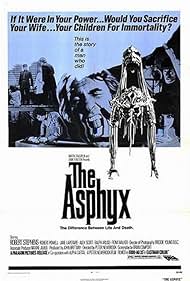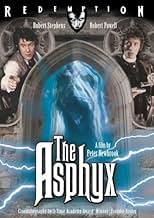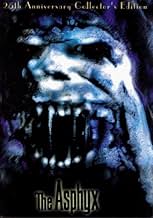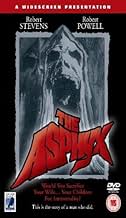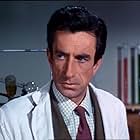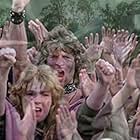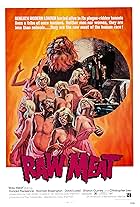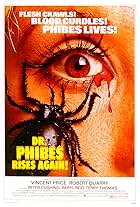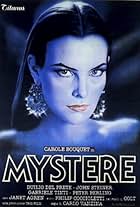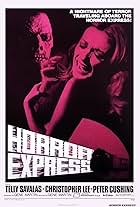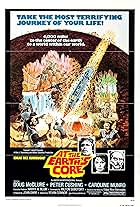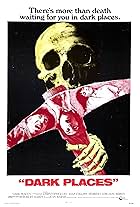IMDb RATING
6.2/10
3.2K
YOUR RATING
English country squire Sir Hugo Cunningham searches for immortality by literally 'bottling up' the Spirit of the Dead, or Asphyx.English country squire Sir Hugo Cunningham searches for immortality by literally 'bottling up' the Spirit of the Dead, or Asphyx.English country squire Sir Hugo Cunningham searches for immortality by literally 'bottling up' the Spirit of the Dead, or Asphyx.
Joe Wadham
- Police Officer at Accident Scene
- (uncredited)
- Director
- Writers
- All cast & crew
- Production, box office & more at IMDbPro
Storyline
Did you know
- TriviaThe main credits state that the film's soundtrack was recorded using a 4-channel quadraphonic sound system. Sadly, there appears to be no evidence of it ever being exhibited in this manner.
- GoofsToward the end of the film Robert Powell picks up a glass beaker. It has the Pyrex stamp on it and its volume is stated as 600ml. Victorian England used imperial (non-metric) measures, and Pyrex was not invented until 1915.
- Quotes
Sir Hugo Cunningham: I obey God's will, my friend, my old friend, my eternal and everlasting friend...
- Alternate versionsThe film was originally shot in Todd-AO 35, a wide-screen process which is normally viewed at 2.35:1. The 1995 UK video featured a much shorter print and missed around 12 minutes of footage including dialogue scenes, an anti-hanging protest before the execution, and the removal of a scene showing the now-immortalized guinea pig being released from its cage. The 2004 Anchor Bay UK DVD features the same print and is presented in an anamorphic 1.85:1 ratio and also uses a pan & scan technique, thus cropping much of the print into a false version of wide-screen. The 2010 Odeon DVD features both the shorter and longer original prints in genuine widescreen.
- ConnectionsFeatured in Elvira's Movie Macabre: The Horror of Death (1986)
Featured review
"The Asphyx" a/k/a "The Horror of Death" is one of the most original yet unheralded English horror films. Set in 1870's England, aristocrat Sir Hugo (Robert Stephens) accidentally photographs an entity (mythological name Asphyx) entering a person's body at their death. Sir Hugo theorizes that each person has their own Asphyx and that if the entity can be imprisoned outside the body, the person will be immortal. Can you guess what happens next?
From the physiological standpoint, the concept is not that different from the idea of vampires and zombies; with the same need to suspend disbelief to really enjoy things. Although like the implications of time travel, half the fun is speculating on the ramifications of the idea.
There is a pleasant and very haunting score and the story has a nice touch of irony as Sir Hugo's first experimental subject is his eventual downfall.
The real strength of this film is the production design. Considerable effort went into the meticulously constructed sets and there was much attention to detail in the various scientific apparatus and instruments. While the historical accuracy of these advanced devices is suspect, they are certainly no harder to accept than the basic premise. All looks great on the big screen and is probably fine on the letter boxed DVD, but the VHS tape is of marginal quality and the 4x3 aspect ratio does not do justice to the frame.
Few films from the era that did a better job of filling their frames than "The Asphyx" (credit to Academy award winning cinematographer Freddie Young), but this just magnifies the problems of the full-screen version. It appears that the 1989 Interglobal Home Video trimmed nine minutes from the film and was recorded at the LP speed, so you should avoid that one if possible.
Then again, what do I know? I'm only a child.
From the physiological standpoint, the concept is not that different from the idea of vampires and zombies; with the same need to suspend disbelief to really enjoy things. Although like the implications of time travel, half the fun is speculating on the ramifications of the idea.
There is a pleasant and very haunting score and the story has a nice touch of irony as Sir Hugo's first experimental subject is his eventual downfall.
The real strength of this film is the production design. Considerable effort went into the meticulously constructed sets and there was much attention to detail in the various scientific apparatus and instruments. While the historical accuracy of these advanced devices is suspect, they are certainly no harder to accept than the basic premise. All looks great on the big screen and is probably fine on the letter boxed DVD, but the VHS tape is of marginal quality and the 4x3 aspect ratio does not do justice to the frame.
Few films from the era that did a better job of filling their frames than "The Asphyx" (credit to Academy award winning cinematographer Freddie Young), but this just magnifies the problems of the full-screen version. It appears that the 1989 Interglobal Home Video trimmed nine minutes from the film and was recorded at the LP speed, so you should avoid that one if possible.
Then again, what do I know? I'm only a child.
- aimless-46
- Dec 1, 2005
- Permalink
- How long is The Asphyx?Powered by Alexa
Details
- Runtime1 hour 23 minutes
- Aspect ratio
- 2.35 : 1
Contribute to this page
Suggest an edit or add missing content

